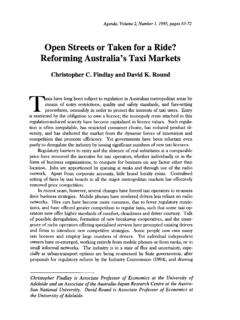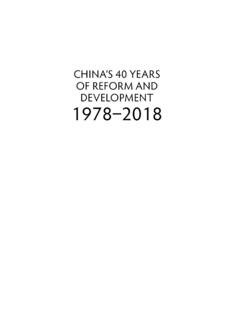Transcription of Human resource management practices in Japan: Are they ...
1 77 Human resource management practices in japan : Are they really changing?Meaghan PowellThe typically Japanese ways in which Japanese companies have long arranged their Human resource practices are certainly changing. However, due to the entrenched nature of these practices and the significance of culture and tradition in japan , these changes are slow and somewhat This essay first explains the specific features of traditional Japanese Human resource management practices . It then goes on to explore the economic environment of japan and how this has informed the evolution of Japanese Human resource management practices .
2 The ways in which these traditional Human resource practices are changing are then interrogated. It is clear that a tension exists in Japanese Human resource practices between old and new: globalisation and economic factors have necessitated changes, however, traditional culture and ingrained mindsets, which inevitably inform Human resource management practices , have resisted these changes. It is correct to say that Japanese Human resource practices are really changing, however, these changes are limited in some Geert Hofstede, What About japan ? Accessed 5 October 2016: MERICI VOLUME 2, 201678 Traditional Japanese Human resource practicesJapanese culture is ancient and Its rich traditions have manifested in a system of unique Human resource management practices .
3 Some core features of Japanese Human resource management include lifetime employment, seniority-based wage and promotion, and enterprise Other notable Japanese Human resource management practices include a particular quality management system, consensus decision-making, employee loyalty to the company and a lack of gender equality in the employmentTraditionally, Japanese companies recruit graduates and guarantee them employment with the company for the entirety of the their There are a number of advantages to the practice of lifetime employment for both employees and the company.
4 The company benefits as the stability of lifetime employment inspires devotion and loyalty in employees, which in turn generates improved employee Employees are also provided with continual training in all areas of the company, making them versatile employees, with a range of skills and abilities that they can contribute to the company throughout their Lifetime employment also leads to a decreased turnover rate for the company, which means that talent is retained within the company, so the company receives a return on the Human resources that it has invested 2 Hofstede, What About japan ?
5 3 Florent Chleide. 2015. Japanese management : Cultural Challenges and Coping Strategies. Master s thesis, Louvain School of management , Universit catholique de Louvain, Chleide, Japanese management .5 Kristina Lazaridi. 2012. Particularities of Japanese management . Journal of Business 1(2): 29 34, Chleide, Japanese management .8 resource management practices IN JAPAN79 For employees, the primary advantage of lifetime employment is stability employees are guaranteed to receive a pension after Lifetime employment also provides a strong platform for career development and steady salary Seniority-based wage and promotion systemHierarchy and respect for elders are key elements of Confucianism.
6 A philosophy that strongly informs Japanese culture and This paradigm is reflected in the seniority-based wage and promotion practice in Japanese Human resource management . As employees gain knowledge and experience over time in a company, they earn new opportunities such as promotions and wage The benefit of this system is that it guarantees career development and pay increases for employees who work in the company for a significant period of However, critics of the system argue that it does not allow new talent to be merged with experience and those with specialised skills cannot be promoted to the already crowded executive ranks.
7 14 Enterprise unionism Enterprise unions exist in almost every Japanese company, and act as an intermediary between staff (except management ) and the company ( management ).15 The managers meet with the union to discuss issues such as salaries, strategies and employee These issues are approached and resolved by both parties with harmony and cooperation as the guiding cultural 9 Confucianism. New World Encyclopedia, last modified 13 June 2013, Lazaridi, Particularities of Japanese management .13 Chleide, Japanese management .14 Lazaridi, Particularities of Japanese management .
8 16 Chleide, Japanese management .17 VOLUME 2, 201680 Quality management systemHigh-quality production has been a key strength of the Japanese This may be attributed to the focus on quality management in Japanese Human resource practices . In Japanese companies, quality control circles are established, consisting of six to 12 employees (ranging from upper management to ordinary workers) on a voluntary Meetings are held once a week, where employees in the circle express ideas about how to innovate at each stage of production, in order to increase the competitiveness of the The benefit of quality control circles is that they foster mutual respect between members of the company at different The circles also encourage feedback and a variety of ideas from a range of members of the company, giving those who will most likely implement the ideas in the company the workers ownership of those ideas.
9 This system fosters a collective sense of trust and commitment. Consensus decision-making There is an emphasis in Japanese culture and business on consensus decision-making; everyone in the company should collectively agree on the objectives and decisions of the company, and all conflict should be This consensus system is known in japan as the ringi system and is one of the most important Human resource management practices in Decisions are made with regard to the long-term impacts of such a decision, rather than just the immediate short-term Japanese business decisions are made in a structured, logical and thoughtful 18 Ralf Bebenroth and Toshihiro Kanai (editors).
10 2011. Challenges of Human resource management in japan . Oxford: Chleide, Japanese management .20 Lazaridi, Particularities of Japanese management .24 Chleide, Japanese management .25 resource management practices IN JAPAN81 employee loyalty to his/her company Companies in japan are built upon the philosophy that employees in the company are family .26 Therefore, employees are extremely loyal to their company and place high importance on the performance of the company as a There is an overall collective mindset in the firm (and Japanese society at large) whereby individuals are rarely singled out for praise or Employees often work overtime without pay in order to contribute to the company s well-being.




